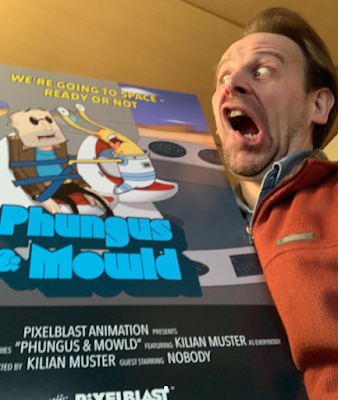How Kilian Muster Created an Entire TV Show, Phungus & Mowld, in His Spare Time Using MOHO - Featured Artist (Webinar Replay)
 |
| Phungus & Mowld One Sheet with Creator Kilian Muster. Photo: @kilianmuster |
Readers of this blog will know I swear by Reallusion's Cartoon Animator as the best animation tool for teams of just one person but Moho, by Lost Marble, is easily a contender and, for many, a superior tool feature for feature.
Recently Lost Marble hosted a free, behind the scenes, one hour webinar with independent animator, and one person team, Killian Muster, creator of the Moho animated TV Series Phungus & Mowld, a Sci-fi comedy influenced by shows like Rick & Morty and Family Guy.
Below is both a preview of what to expect from the series, and the good news that Moho was reacquired by it's original creators back in 2020 (definitely great news that was worth celebrating with an animation).
Killian first started using Moho back in 2001 to create an animated TV commercial, and then for smaller side jobs. He had put his interest in film, storytelling, and animation on the backburner for several decades, working as a designer in many fields. In 2019 he reignited his interest in in animation, creating Phungus & Mowld in his spare time. The pilot episode went on to win several awards at various film festivals.
Initially I thought Killian's webinar replay (embeded below) would be interesting because you could easily do the same thing with Cartoon Animator (or any other animation software). There is always something to be learned from anyone producing TV quality animation all by themselves, in their spare time, while supporting a family and working a full time job.
However, on another level, it's a great insight into what animating with Moho is like in comparison to whatever application you've settled upon. It's even great if Moho is your application of choice since you get to compare your process with someone else.
Personally I've spent a lot of time learning Moho 12. Documenting my process in this blog and going so far as to sort all of Moho's official, free, animation tutorial videos into a logical order that makes sense to a beginner. As a result, I'm very informed on what Moho is capable of in comparison to Cartoon Animator. Ultimately I just didn't find using Moho to be as 'fun' as Cartoon Animator.
On the other hand, Killian appears to have taken a similar journey to me through many different applications including; Animate CC, Toon Boom Harmony, Blender's Grease Pencil, and Cartoon Animator. For him Cartoon Animator is better suited to 'explainer videos' (which is a fair assessment on a surface level). He just kept coming back to Moho.
Below is the FREE 1-hour webinar with Kilian in which he talks about his workflow of creating an independent animated series as a one-man operation using Moho. Specifically he covers:
- His script writing process.
- How he puts together scenes.
- Details various character rigs he has created over time.
- Q&A session.
Some key points I took away from this webinar include:
- Killian had to teach himself how to write scripts and how to animate again with MOHO. Toward the end of the webinar he recommends several Moho learning resources.
- Doesn't storyboard because he doesn't really need to being a one person team. Instead he places his characters in each scene and then uses the camera to frame his shots - which he tends to do after he's animated the characters.
- Likes that characters are vector based making them easy to scale.
- Likes the very versatile rigging system which takes full advantage of vector based characters.
- Moho's physics animation features save him time with more complex effects.
- Uses Affinity Designer for backgrounds rather than draw them directly in Moho because it's easier to update a background across a project by updating the background file and having Moho auto update all the scenes where it is used.
- When animating he starts with the voice audio and does all the lip syncing before animating anything else.
If you would like to know more about Killian and his work visit his PixelBlast Creative website where you can access his production blog and links to other information including his new series Shadywoods.
For more information about Moho, visit: www.mohoanimation.com

Hey thanks for the article and the links! So it looks like I've achieved fame at long last.
ReplyDeleteI actually decided to start storyboarding with episode 3 after all, because I got fed up with having to redraw backgrounds when I get the angle or framing wrong so many times (I dread making BG artwork in the first place). I guess we all live and learn, and many of the established processes are there for a reason...
I guess you've achieved fame if being featured on the 30th ranked site of Feedspot's Top 100 animation sites is achieving fame ;-)
DeleteThanks for stopping by and leaving a comment. Your work almost tempted me to try Moho again, and then I realized I'd have to learn Moho again having not used it for so long.
I hear you on making backgrounds too. I'm definitely more of a character artist. Drawing a background once is bad enough without having to do redraws. Anyway, good to hear you're storyboarding now... who knew storyboards had a purpose? LOL